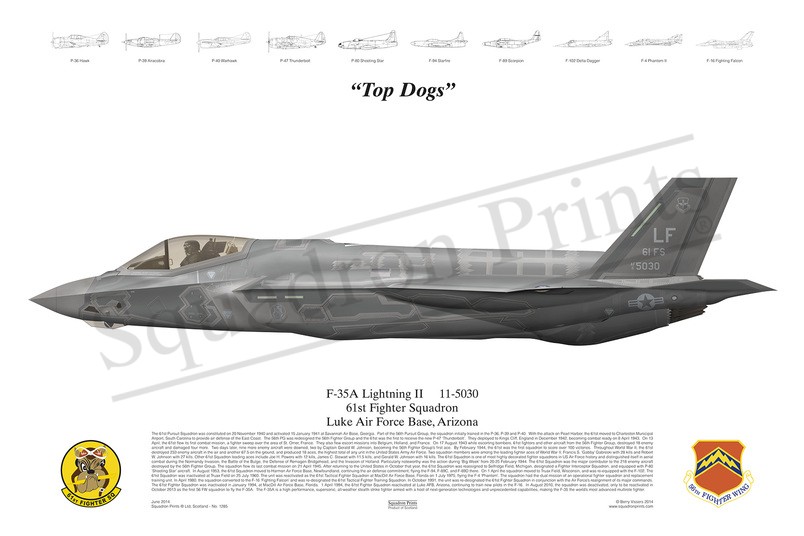#1285 F-35A Lightning II

Purchased products will not feature the Squadron Prints watermark
Description
Squadron Prints Lithograph No. 1285 - F-35A Lighting II, 11-5030 \'61 FS\', 61st Fighter Squadron, Luke Air Force Base, Arizona.
The 61st Pursuit Squadron was constituted on 20 November 1940 and activated 15 January 1941 at Savannah Air Base, Georgia. Part of the 56th Pursuit Group, the squadron initially trained in the P-36, P-39 and P-40. With the attack on Pearl Harbor, the 61st moved to Charleston Municipal Airport, South Carolina to provide air defense of the East Coast. The 56th PG was redesigned the 56th Fighter Group and the 61st was the first to receive the new P-47 ‘Thunderbolt’. They deployed to Kings Cliff, England in December 1942, becoming combat ready on 8 April 1943. On 13 April, the 61st flew its first combat mission, a fighter sweep over the area of St. Omer, France. They also flew escort missions into Belgium, Holland, and France. On 17 August 1943 while escorting bombers, 61st fighters and other aircraft from the 56th Fighter Group, destroyed 18 enemy aircraft and damaged four more. Two days later, nine more enemy aircraft were downed, two by Captain Gerald W. Johnson, becoming the 56th Fighter Group’s first ace. By February 1944, the 61st was the first squadron to score over 100 victories. Throughout World War II, the 61st destroyed 233 enemy aircraft in the air and another 67.5 on the ground, and produced 18 aces, the highest total of any unit in the United States Army Air Force. Two squadron members were among the leading fighter aces of World War II; Francis S. ‘Gabby’ Gabreski with 28 kills and Robert W. Johnson with 27 kills. Other 61st Squadron leading aces include Joe H. Powers with 12 kills, James C. Stewart with 11.5 kills, and Gerald W. Johnson with 16 kills. The 61st Squadron is one of most highly decorated fighter squadrons in US Air Force history and distinguished itself in aerial combat during the Normandy Invasion, the Battle of the Bulge, the Defense of Remagen Bridgehead, and the Invasion of Holland. Particularly noteworthy was the action during ‘Big Week’ from 20-25 February 1944. The 61st Squadron was the major contributor to the 218 enemy aircraft destroyed by the 56th Fighter Group. The squadron flew its last combat mission on 21 April 1945. After returning to the United States in October that year, the 61st Squadron was reassigned to Selfridge Field, Michigan, designated a Fighter Interceptor Squadron, and equipped with P-80 ‘Shooting Star’ aircraft. In August 1953, the 61st Squadron moved to Harmon Air Force Base, Newfoundland, continuing the air defense commitment, flying the F-94, F-89C, and F-89D there. On 1 April the squadron moved to Truax Field, Wisconsin, and was re-equipped with the F-102. The 61st Squadron was inactivated at Truax Field on 25 July 1960. The unit was reactivated as the 61st Tactical Fighter Squadron at MacDill Air Force Base, Florida on 1 July 1975, flying the F-4 ‘Phantom’. The squadron had the dual mission of an operational fighter squadron and replacement training unit. In April 1980, the squadron converted to the F-16 ‘Fighting Falcon’ and was re-designated the 61st Tactical Fighter Training Squadron. In October 1991, the unit was re-designated the 61st Fighter Squadron in conjunction with the Air Force’s realignment of its major commands. The 61st Fighter Squadron was inactivated in January 1994, at MacDill Air Force Base, Florida. 1 April 1994, the 61st Fighter Squadron reactivated at Luke AFB, Arizona, continuing to train new pilots in the F-16. In August 2010, the squadron was deactivated, only to be reactivated in October 2013 as the first 56 FW squadron to fly the F-35A. The F-35A is a high performance, supersonic, all-weather stealth strike fighter armed with a host of next-generation technologies and unprecedented capabilities, making the F-35 the world’s most advanced multirole fighter.
You may also like
-
MQ-1B Predator and MQ-9A Reaper
05-3138; 08-40472d SOS, 919th SOWHurlburt Field, Florida
